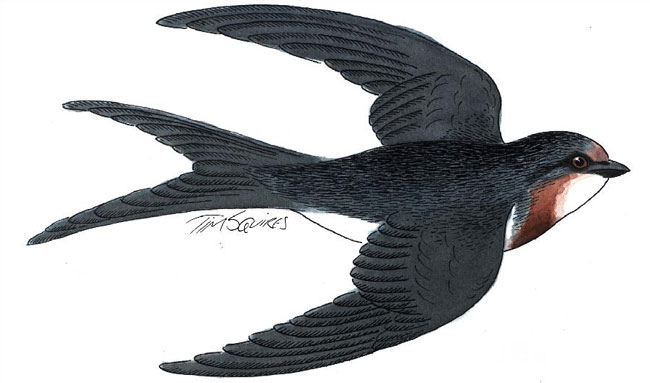 The welcome swallows were late in making an appearance in my valley this year – September 3rd instead of September 2nd.
The welcome swallows were late in making an appearance in my valley this year – September 3rd instead of September 2nd.
Spring might officially arrive on the first day of September but on the Knowler calendar it is always the second day of September. Only once in a decade have the swallows missed their deadline and that was an exceptional year with storms and southerly winds in the first week of September which no doubt halted the swallows’ progress from their wintering grounds on the mainland.
I’m always relieved when the first swallows arrive. Towards the end of winter I often think of them making their way south on the long and epic journey from their wintering grounds in south-east Queensland. I marvel each year as the silver wattles break into yellow spring blossom how such seemingly fragile birds, only 15 centimetres in length, make it acrossBass Strait. A good north or north-westerly wind will bring them through, though, and my first swallows this year had arrived on such winds as spring got under way.
Much myth and folklore is attached to swallows worldwide. It was once thought they migrated to the moon in winter, and the first European settlers in Tasmania thought that the welcome swallows they saw were birds from their homeland which returned to the British Isles each year. The settlers were mistaking our welcome swallows with the European species which, although not travelling to Australia, still make an epic journey of their own to South Africa.
The welcome swallow is a little less showy than the European one, with less russet red on its neck and a more muted glossy-blue plumage on its head and back, but it is still spectacular all the same. Next time they are about, take a moment to study them carefully as they sweep across city parks, seemingly oblivious to humans around them. A fine place to watch swallows is the Parliament Lawns in central Hobart.
I might delight in the sight and sound of swallows – whose joyous twittering is an essential part of spring and summer – but there are many who do not share my view of them, and regard them as a kind of pest.
I was horrified as the first swallows were arriving to hear accounts from a friend who said her mother routinely destroys the swallows’ mud nests on her property and sometimes kills their young.
The property owner said she did not like the mess the swallows left, their droppings soiling the ground underneath nests, and splattering against her windows.
A few days later I heard a similar complaint from a man in the Launceston who said he grew tired in summer of cleaning the expansive windows of his ranch-style property.
This attitude is in contrast to people who actively encourage swallows to nest on their properties, sometimes installing ledges under the eaves of roofs to assist them in nest building. In dry weather, swallow-lovers are also known to run a hose-pipe over hard soil and churn up mud to help the swallows gather nest-building material.
These views on the swallow might represent two extremes, but generally many people find that the problem with welcoming wildlife into their lives is that it comes on its own terms. The welcome swallow, the new holland honeyeater and yellow wattlebird hold no respect for the sanitised, ordered and manicured world of suburbia.
Splashes of bird dropping on the windows, a neat flowerbed upended by a forest raven, or a bird of suburbia, the blackbird, having the effrontery to scatter leaf-litter across the lawn – a love of nature comes at a cost but it is a small price to pay for what wildlife can mean to our lives.